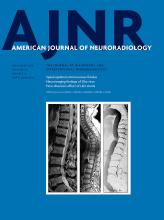Research ArticleNeurointervention
Flow-Diversion Effect of LEO Stents: Aneurysm Occlusion and Flow Remodeling of Covered Side Branches and Perforators
F. Cagnazzo, M. Cappucci, C. Dargazanli, P.-H. Lefevre, G. Gascou, C. Riquelme, R. Morganti, V. Mazzotti, A. Bonafe and V. Costalat
American Journal of Neuroradiology November 2018, 39 (11) 2057-2063; DOI: https://doi.org/10.3174/ajnr.A5803
F. Cagnazzo
aFrom the Neuroradiology Department (F.C., M.C., C.D., P.-H.L., G.G., C.R., A.B., V.C.), University Hospital Güi-de-Chauliac, Centre Hospitalier Universitaire de Montpellier, Montpellier, France
M. Cappucci
aFrom the Neuroradiology Department (F.C., M.C., C.D., P.-H.L., G.G., C.R., A.B., V.C.), University Hospital Güi-de-Chauliac, Centre Hospitalier Universitaire de Montpellier, Montpellier, France
C. Dargazanli
aFrom the Neuroradiology Department (F.C., M.C., C.D., P.-H.L., G.G., C.R., A.B., V.C.), University Hospital Güi-de-Chauliac, Centre Hospitalier Universitaire de Montpellier, Montpellier, France
P.-H. Lefevre
aFrom the Neuroradiology Department (F.C., M.C., C.D., P.-H.L., G.G., C.R., A.B., V.C.), University Hospital Güi-de-Chauliac, Centre Hospitalier Universitaire de Montpellier, Montpellier, France
G. Gascou
aFrom the Neuroradiology Department (F.C., M.C., C.D., P.-H.L., G.G., C.R., A.B., V.C.), University Hospital Güi-de-Chauliac, Centre Hospitalier Universitaire de Montpellier, Montpellier, France
C. Riquelme
aFrom the Neuroradiology Department (F.C., M.C., C.D., P.-H.L., G.G., C.R., A.B., V.C.), University Hospital Güi-de-Chauliac, Centre Hospitalier Universitaire de Montpellier, Montpellier, France
R. Morganti
bSection of Statistics (R.M., V.M.), University Hospital of Pisa, Pisa, Italy.
V. Mazzotti
bSection of Statistics (R.M., V.M.), University Hospital of Pisa, Pisa, Italy.
A. Bonafe
aFrom the Neuroradiology Department (F.C., M.C., C.D., P.-H.L., G.G., C.R., A.B., V.C.), University Hospital Güi-de-Chauliac, Centre Hospitalier Universitaire de Montpellier, Montpellier, France
V. Costalat
aFrom the Neuroradiology Department (F.C., M.C., C.D., P.-H.L., G.G., C.R., A.B., V.C.), University Hospital Güi-de-Chauliac, Centre Hospitalier Universitaire de Montpellier, Montpellier, France

References
- 1.↵
- 2.↵
- 3.↵
- Aydin K,
- Barburoglu M,
- Sencer S, et al
- 4.↵
- Pumar JM,
- Arias-Rivas S,
- Rodriguez-Yanez M, et al
- 5.↵
- 6.↵
- Gawlitza M,
- Januel AC,
- Tall P, et al
- 7.↵
- Clarençon F,
- Di Maria F,
- Gabrieli J, et al
- 8.↵
- 9.↵
- Roy D,
- Milot G,
- Raymond J
- 10.↵
- Gross BA,
- Frerichs KU
- 11.↵
- 12.↵
- 13.↵
- 14.↵
- Vedantam A,
- Rao VY,
- Shaltoni HM, et al
- 15.↵
- 16.↵
- Yu SC,
- Kwok CK,
- Cheng PW, et al
- 17.↵
- 18.↵
- 19.↵
- 20.↵
- Brinjikji W,
- Kallmes DF,
- Cloft HJ, et al
- 21.↵
- Raz E,
- Shapiro M,
- Becske T, et al
- 22.↵
- 23.↵
- Saleme S,
- Iosif C,
- Ponomarjova S, et al
- 24.↵
- Cagnazzo F,
- Mantilla D,
- Lefevre PH, et al
- 25.↵
- Rouchaud A,
- Brinjikji W,
- Cloft HJ, et al
- 26.↵
- 27.↵
- 28.↵
- Inoue T,
- Croce K,
- Morooka T, et al
- 29.↵
- Puffer RC,
- Kallmes DF,
- Cloft HJ, et al
- 30.↵
- Durst CR,
- Starke RM,
- Clopton D, et al
- 31.↵
- Makoyeva A,
- Bing F,
- Darsaut TE, et al
- 32.↵
- Rouchaud A,
- Leclerc O,
- Benayoun Y, et al
- 33.↵
- Kallmes DF,
- Hanel R,
- Lopes D, et al
- 34.↵
- 35.↵
- Fiorella D,
- Albuquerque FC,
- Deshmukh VR, et al
- 36.↵
- 37.↵
- 38.↵
- Machi P,
- Costalat V,
- Lobotesis K, et al
In this issue
American Journal of Neuroradiology
Vol. 39, Issue 11
1 Nov 2018
Advertisement
F. Cagnazzo, M. Cappucci, C. Dargazanli, P.-H. Lefevre, G. Gascou, C. Riquelme, R. Morganti, V. Mazzotti, A. Bonafe, V. Costalat
Flow-Diversion Effect of LEO Stents: Aneurysm Occlusion and Flow Remodeling of Covered Side Branches and Perforators
American Journal of Neuroradiology Nov 2018, 39 (11) 2057-2063; DOI: 10.3174/ajnr.A5803
0 Responses
Flow-Diversion Effect of LEO Stents: Aneurysm Occlusion and Flow Remodeling of Covered Side Branches and Perforators
F. Cagnazzo, M. Cappucci, C. Dargazanli, P.-H. Lefevre, G. Gascou, C. Riquelme, R. Morganti, V. Mazzotti, A. Bonafe, V. Costalat
American Journal of Neuroradiology Nov 2018, 39 (11) 2057-2063; DOI: 10.3174/ajnr.A5803
Jump to section
Related Articles
Cited By...
- Flow-Diversion Treatment for Unruptured ICA Bifurcation Aneurysms with Unfavorable Morphology for Coiling
- Distal anterior cerebral artery aneurysms treated with flow diversion: experience of a large-volume center and systematic review of the literature
- Early experience treating intracranial aneurysms using Accero: a novel, fully visible, low profile braided stent with platinum-nitinol composite wire technology
This article has not yet been cited by articles in journals that are participating in Crossref Cited-by Linking.
More in this TOC Section
Similar Articles
Advertisement











